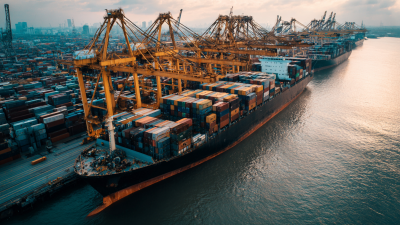In the rapidly evolving landscape of global trade, efficient cargo movement stands as a critical factor driving economic growth and sustainability. According to a report by the International Maritime Organization, approximately 80% of global trade by volume is carried by sea, highlighting the significance of maritime logistics in cargo movement. Furthermore, the World Bank estimates that improvements in logistics performance can boost trade volumes by as much as 15%, underscoring the importance of optimized supply chains. The reliance on multimodal transport solutions — integrating air, rail, and road networks — enhances the speed and cost-effectiveness of cargo movement, allowing businesses to meet increasing consumer demands and streamlining operations. Understanding the underlying principles of efficient cargo movement is essential for stakeholders to navigate the complexities of supply chains and ensure a competitive edge in the global market.

Logistics plays a pivotal role in enhancing efficiency in global cargo movement, serving as the backbone of international trade. In an interconnected world, the seamless transfer of goods relies heavily on advanced logistics strategies that optimize supply chain processes. Efficient logistics not only reduces transit times but also minimizes costs, making global trade more competitive. Key aspects include real-time tracking, demand forecasting, and strategic warehousing, all of which contribute to smoother operations.
**Tips for Improving Logistics Efficiency:**
1. Invest in technology: Leverage logistics management software to gain real-time visibility into inventory levels and shipment status. This helps in making data-driven decisions and optimizing routes.
2. Develop strong partnerships: Collaborate with reliable transport and freight forwarders who understand the nuances of global trade, ensuring that cargo moves smoothly through various channels.
3. Focus on sustainability: Implement eco-friendly practices that not only cater to regulatory requirements but also reduce operational costs and enhance brand reputation.
By prioritizing logistics efficiency, businesses can ensure their cargo movements are timely and cost-effective, ultimately leading to a more successful global operation.
The landscape of global trade is continually evolving, particularly in the realm of cargo handling and tracking. Innovative technologies such as RFID (Radio-Frequency Identification), IoT (Internet of Things), and blockchain are revolutionizing how goods are moved across borders. These advancements facilitate real-time tracking of shipments, allowing companies to monitor their cargo at every stage of its journey. With the ability to gather data from interconnected devices, businesses can optimize their supply chain logistics, reducing delays and improving efficiency.
**Tip:** Consider integrating IoT sensors in your shipping processes. These devices can provide valuable data on temperature, humidity, and location, ensuring that conditions remain optimal for sensitive cargo.
Additionally, blockchain technology is enhancing transparency in cargo movement. By maintaining a secure, immutable record of transactions, it reduces the risk of fraud and streamlines customs clearance processes. This transparency fosters trust among stakeholders and simplifies disputes, ultimately leading to smoother international trade operations.
**Tip:** Explore partnerships with tech companies specializing in blockchain solutions. Implementing these systems can help in tracking cargo history and streamlining documentation efforts.
| Technology | Description | Impact on Cargo Movement | Adoption Rate (%) |
|---|---|---|---|
| IoT Tracking Devices | Devices that use sensors to monitor cargo conditions in real-time. | Increases visibility and reduces losses due to theft or spoilage. | 68 |
| Blockchain Technology | A decentralized ledger technology for secure data transactions. | Enhances transparency and accountability in supply chains. | 32 |
| Autonomous Vehicles | Self-driving trucks and drones for transporting cargo. | Reduces human error and operational costs, increases delivery speed. | 21 |
| AI and Machine Learning | Data analysis tools to optimize routes and warehouse management. | Enhances efficiency and reduces delays in cargo handling. | 45 |
| Robotics | Automated systems for picking, packing, and loading cargo. | Increases speed and accuracy in cargo handling operations. | 38 |
Efficient cargo movement is integral to the success of global trade, yet it faces numerous challenges that must be navigated. One prevalent obstacle is the cost and complexity associated with nearshoring, where businesses attempt to relocate supply chains closer to their operational base. This strategy often introduces regulatory hurdles and data visibility gaps that can complicate logistics. Companies striving to maintain robust sourcing can find it particularly difficult to balance these challenges while simultaneously achieving financial efficiency.
Moreover, the issue of barriers in global trade extends beyond operational challenges; it encompasses the regulatory landscape, technology adoption, and collaboration across borders. For instance, sector-specific agreements and technological advancements are critical in facilitating smoother trade. Areas like Africa’s container shipping are working to address such hurdles, aiming to enhance their role in the global supply chain. By actively overcoming these barriers, countries and companies can foster a more interconnected and resilient global trade ecosystem that benefits all stakeholders involved.

 Sustainable practices in cargo transportation are essential for enhancing efficiency and reducing environmental impact in global trade. One significant approach is the optimization of shipping routes, which minimizes fuel consumption while ensuring timely deliveries. Utilizing advanced software and data analytics allows companies to analyze weather patterns, port congestion, and demand fluctuations. This strategic planning not only decreases greenhouse gas emissions but also cuts operational costs, ultimately benefiting both the economy and the planet.
Sustainable practices in cargo transportation are essential for enhancing efficiency and reducing environmental impact in global trade. One significant approach is the optimization of shipping routes, which minimizes fuel consumption while ensuring timely deliveries. Utilizing advanced software and data analytics allows companies to analyze weather patterns, port congestion, and demand fluctuations. This strategic planning not only decreases greenhouse gas emissions but also cuts operational costs, ultimately benefiting both the economy and the planet.
Moreover, the adoption of green technologies is transforming the logistics industry. The transition to electric vehicles and the utilization of alternative fuels, such as biofuels and hydrogen, are crucial steps towards sustainable cargo movement. Innovations such as automated and smart warehouses enhance inventory management and reduce waste, aligning with the sustainability goals. By integrating these practices into their logistics strategies, companies can significantly improve their carbon footprint while meeting the increasing demand for responsible trade practices from consumers and stakeholders alike.
The global trade landscape is rapidly evolving, driven by technological advancements, changing consumer behaviors, and environmental concerns. One significant trend shaping cargo movement strategies is the increasing adoption of automation and digitalization in logistics. Companies are leveraging technologies like AI and IoT to enhance visibility in supply chains, enabling real-time tracking and more efficient inventory management. This shift not only optimizes delivery times but also reduces operational costs, allowing businesses to remain competitive in an increasingly interconnected world.
Another key trend is the growing emphasis on sustainability. As consumers become more environmentally conscious, companies are reevaluating their cargo movement strategies to minimize carbon footprints. This includes transitioning to greener transportation methods, optimizing shipment routes, and utilizing energy-efficient practices in warehouses. Furthermore, global regulations are pushing for sustainable practices, compelling businesses to innovate their logistics operations to comply with these new standards. By embracing sustainability, companies can improve their brand image and meet the demands of a market that prioritizes eco-friendliness.












